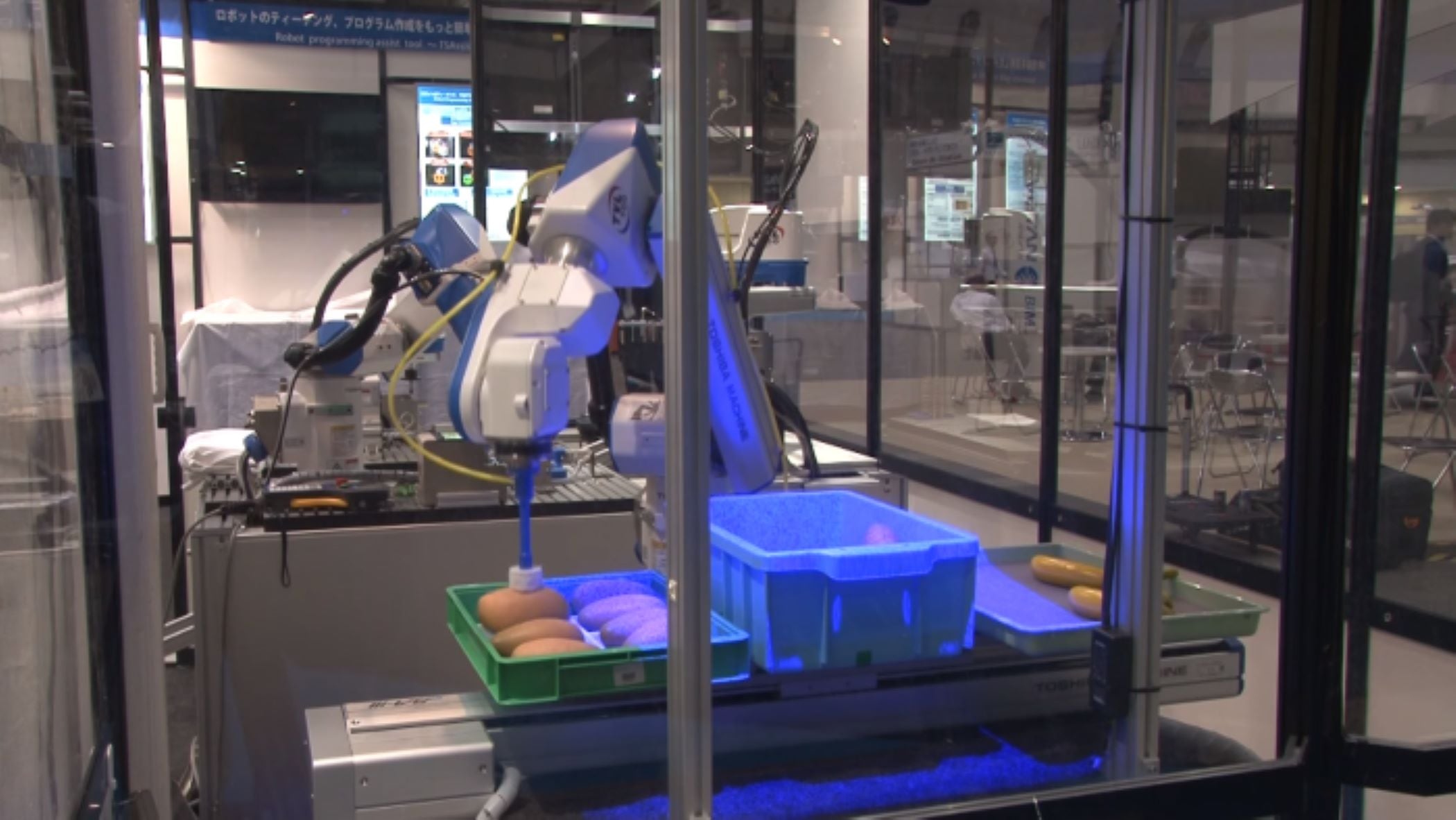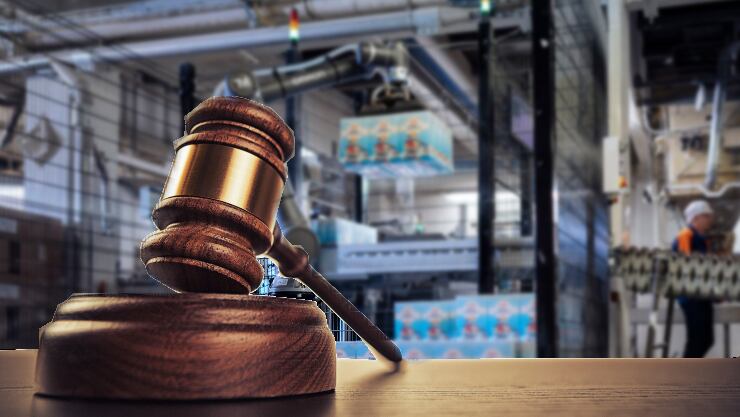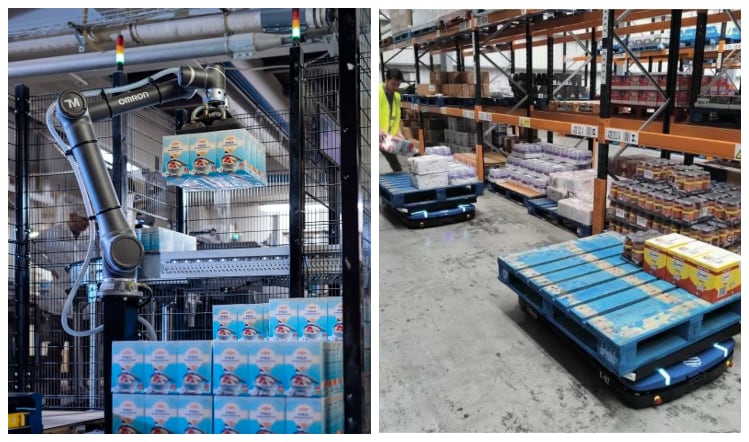While training robots to complete household chores is an appealing idea, for cost reasons, developing and programming automated systems to fulfil such everyday tasks simply isn’t viable – at least not yet. However, robotic technologies are advancing quickly and they are already widely used on food production lines and in industrial kitchens.
To date, robotic technology has been typically used for end-of-line applications, such as palletising food and drink products prior to distribution and other tasks that eliminate the need for humans to do menial or hazardous activities, such as heavy lifting.
Some robots have also been used for picking and packing applications, although depending on the nature of the food product, robotic grips may lack sufficient dexterity and/or sensitivity for the task at hand.
Cobots with a human touch
The latest generation of industrial collaborative robots or ‘cobots’ have improved significantly. They are now capable of undertaking a much wider range of tasks from sorting fragile or frozen food products on a production line to decorating desserts and cakes.
Increased connectivity in food and drink processing plants means that static cobots, or those placed on AGVs, can be re-programmed quickly to fulfil different tasks whilst linked to a central control system.
Although cobots have been used for pick and place operations in packing and distribution for some time, their use in food handling has been limited. Food products are often fragile, slippery or irregular in shape and require a secure grip and delicate handling. For practicality, robotic arms with sensitive grippers or end-effectors are required to transfer them to the next machine or other processing operations.
Significant advancement in the development of end-effectors for use in food handling applications has already led to a number of commercially viable products. For example, mGrip grippers produced by Soft Robotics Inc, are suitable for high-speed automated picking solutions using 3D machine vision.
A recent European patent application filed by the company points to a solution capable of handling meat products, which can be difficult to handle using a conventional gripper, especially meat products with different configurations of bones as the location of the bones can alter the most effective way to pick it up.
The use of sensors is helping to improve the functionality of food handling robots by enabling them to handle and sort delicate food products with a high degree of accuracy. For example, uSkin magnetic force sensors, developed by Xela Robotics, can be used to detect the size and shape of fruit to avoid bruising the fruit and can even be used to detect fruit ripeness to improve quality and reduce waste. The patents held by Xela in this case relate to magnetic interference compensation required for the magnetic force sensors to work effectively.
Artificial intelligence (AI) and machine learning are adding further power to robotic systems in food processing applications. Robotic food sorting systems, developed by TOMRA Systems, can detect the size and quality of food products.
The systems are best known for their use in detecting and rejecting toxic weeds, which are commonly harvested along with green beans and baby leaf spinach. The accuracy of this high-tech sorting system is achieved by combining industry-leading sensors and high-resolution lasers with the company’s proprietary biometric identification technology, AI machine learning and big data analysis.
End-to-end automation in action
Growing use of bespoke Enterprise Resource Planning (ERP) software is enabling more food and drink processers to introduce end-to-end automation, where robotic systems are programmed to use just the right amount of raw ingredients to create custom orders without the need for multiple human touchpoints. These systems can help to standardise processes, minimise waste and improve operational efficiency; allowing plants to achieve more in less time.
Many of these advanced end-to-end systems use Autonomous Mobile Robots (AMRs), which have become less expensive to purchase in recent years. These self-driving and self-navigating robots offer enhanced flexibility in terms of their functionality and can be used in modular systems that can be added to over time.
Kuka Robotics has developed technologies that allow industrial businesses to establish a digital twin of their existing operations in order to simulate the use of robots and automated systems before any investment is made. This allows the business to accurately assess the benefits in terms of productivity and waste minimisation that will be achievable over time.
Using AMRs in this way can help to streamline production processes whilst mitigating the risk of human error or limiting the exposure of human workers to hazardous environments. In some cases, they are removing some of the tasks that are most challenging for humans, such as working in cold storage areas.
For example, AMRs developed by iFollow have been specifically designed for use in a cold store environment. They can transport payloads of between 300-1,500kg at a temperature as low as -25°C and their electronic componentry is protected by an innovative system that prevents condensation and therefore icing. Other AMRs could be refined to fulfil food processing applications in this emerging space and specialist advice should be sought.
Mitigating food safety risks
Among the key benefits of end-to-end automation is the reduction in human touchpoints, which can help to mitigate the risk of contamination and other food safety issues. However, the use of robots in food and drink supply chains brings its own food safety challenges, not least the need to maintain and clean machinery that comes into contact with food products during the production process.
An innovative automated weighing system developed by OAL offers accurate and consistent weighing and handling of ingredients, significantly reducing the risk of contamination. It is especially useful when handling raw products such as fruit and vegetables.
As well as helping to mitigate the risk of contamination on the production line, robotics systems can be used to keep machinery and other robotic systems clean. For example, a system developed by JMP Solutions uses high-powered water to deep clean processing machinery at the end of each operating cycle.
Growing interest in the use of soft grippers as a means of improving the efficiency and functionality of food sorting robots has encouraged some innovators to explore ways to de-risk their use by introducing food safety benefits.
Soft Robotics Inc has recently filed a European patent application directed to end-effector designs that eliminate crevices, which could be difficult to clean and harbour bacteria.
Advanced automated systems that provide a greater assurance of food safety, whilst facilitating robust tracking and monitoring, will ultimately help to drive investment in automation. Whilst mitigating the risk of product recalls, adopting such systems could help to protect the user’s brand image and strengthen supply partnerships too.
Last word for innovators
The fast pace of development in the field of automation for use in the food and drink industry means that innovators should take extra care when deciding where to focus their R&D spend. Understanding the patent landscape is important to avoid infringing others’ intellectual property (IP) rights.
It could also help innovators to spot ‘gaps’ in the market, where it might be possible to develop a technological solution for a niche application and secure a valuable 20-year period of commercial exclusivity.
As many robotic technologies were originally developed for application in manufacturing and the warehouse and logistics sector, it may also be worthwhile to review existing patent portfolios, to see if there are opportunities to protect food industry applications with existing patents and refine existing technologies for specific food industry applications that could be further protected.




